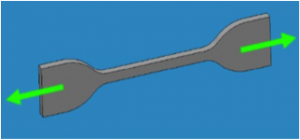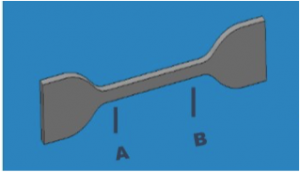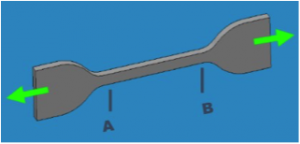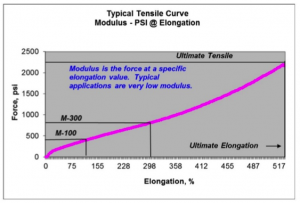Tensile strength, elongation, and modulus are often used as qualification criteria when specifying rubber and polyurethane material. They can also serve as control criteria when testing finished products, such as tubes and straps. These three material physical property concepts can easily be confused. Let’s try to keep this as simple as possible.
 Tensile Strength
Tensile Strength
Tensile strength is usually measured as the amount of force in pounds per square inch (psi) or megapascals (MPa) required to pull a specimen to the point of material failure. This test is accomplished by placing a dumbbell shaped specimen into the grips, or jaws, of a tensometer. The tensometer pulls the grips apart steadily until the dumbbell breaks. The force at material rupture is known as ultimate tensile strength, which is commonly shortened to tensile strength or tensile.
Typical Tensile Strengths
Human hair 10 MPa
60 Shore A EPDM 10 MPa
70 Shore D Cast Urethane 45 MPa
Stainless Steel 860 MPa
 Elongation
Elongation
Elongation is measured by applying tensile force, or stretching the material in the same manner as described previously, and determining the change in length from original. Elongation is expressed as a percentage of the original length. Ultimate elongation is the percentage change in length from original to rupture.
 Modulus
Modulus
Modulus is the force at a specific elongation value, ie 100% or 300% elongation. Expressed in pounds per square inch (psi) or megapascals (MPa), modulus is most widely used for testing and comparison purposes at 100% elongation. This is referred to as “M100” or modulus 100.
In general, higher durometer materials have a higher modulus.
 The Golden Nugget
The Golden Nugget
Although it may be important to know and consider when a material will fail, aka ultimate tensile, more important may be the lower modulus data when comparing materials for a particular application. In general, parts in application often function between the M10 and M25 range of the tensile curve, rather than higher up the curve. If parts were designed to function close to ultimate tensile, we would expect to see part failures when used in the more extreme limits of their application.
Want to see the Tensometer in action? Take a look!



